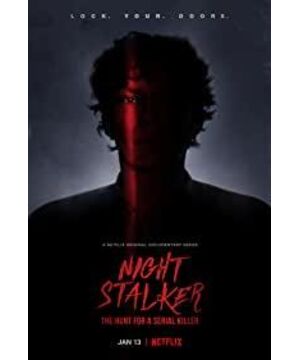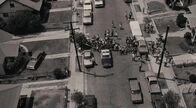"American Horror Story: 1984" has such a villain, known as "Nightcrawler", who always sneaks into houses in the middle of the night, brutally tortures the owner to death, and leaves a pentagram pattern on the wall.
He is a Satanist, deals with the devil, and has immortality. He has been chasing and killing the heroine Brook, and brutally killing all the protagonists by brutal means. He is an out-and-out serial perverted murderer.
In reality, a serial killer known as the Night Stalker also exists. His name is Richard Rewa Ramirez, one of the most notorious serial killers of all time.
Now, Netflix has made a crime documentary about him. With a large amount of data, survivors and family members' oral accounts, interspersed with the memories of the police detective in charge of the case at that time, it shows the whole process of arresting the culprit who committed countless heinous crimes and caused panic among the people.
Night Stalker: The Hunt for a Serial Killer
This article contains spoilers.
1
On March 17, 1985, in Los Angeles, a middle-aged woman named Dale Okazaki was shot dead at her home. Shortly after her death, her roommate Maria was also shot by a murderer when she returned home.
But Maria was lucky, the killer missed the shot, and the bullet hit her key, and Maria narrowly escaped. Therefore, I had close contact with the murderer and saw his appearance clearly.
40 minutes later, the absconded murderer met Yu Cailian, an Asian woman who was driving alone. He dragged the innocent Yu Cailian out of the car, shot her for no reason, dumped the body on the side of the road, and walked away.
The police speculated from the 22-caliber bullets left at the scene that the two seemingly unrelated cases were committed by the same suspect. They drew a portrait of the suspect based on the description of the survivor Maria.
Unexpectedly, the completed portrait actually matched the portrait of the suspect in another case. This shows that the murderer committed not only the two murders mentioned above.
He has many more crimes undiscovered.
To better understand the killer, the police found a psychologist. Experts analyzed that the murderer chose to attack the victim head-on, probably enjoying the process.
When the victim sees him and fears, the murderer will be greatly satisfied. This kind of morbid psychology is not formed in a day or two, and after enjoying the fun of crime, he will continue to kill.
Sure enough, a few days later, a middle-aged couple was killed at home. Money was looted, and the male deceased was shot in the head in his sleep and died on the spot. His wife was killed after being sexually assaulted, and the killer gouged out the female victim's eyes and took him away from the scene.
As in the previous two cases, the killer still used a 22-gauge firearm. He left key clues on the scene, clear shoe prints.
For a long time after that, in almost every case of burglary, murder and rape, the first thing the police had to do was to look for shoe prints to confirm whether the case was committed by the same person.
According to police investigation, this is a pair of Avia sneakers in size 44.5. According to the description of the survivors, it was determined that the murderer was wearing the only pair of black Avia sneakers in Los Angeles at the time.
Just as the police took this as an opportunity to search for the murderer, another pedophile who committed multiple child abduction and molestation cases appeared on the streets of Los Angeles.
He abducted unsuspecting children from parks and streets, and even pried open windows in the middle of the night, kidnapped the sleeping children, and carried them to his car.
Because serial killers usually have a fixed killing pattern and a habit of choosing victims, no one connected the two types of cases at the time.
Except for Detective Jill, who was in charge of the home shooting.
When he looked through the child molestation case files, he found that many victims' descriptions of the suspects were strikingly consistent with the descriptions of the survivors of the burglary. Black curly hair, tall skinny, bad body odor, mouth full of bad teeth... Even the tone of the murderer's violent words to them is very similar.
Jill told his colleagues about his speculation, but everyone just thought he was a whimsical boy, and didn't take his speculation seriously at all.
Until the police confirmed this fact from the footprints at the scene.
Although the police did not make the discovery public, the media reports and the large number of victims sent the entire Los Angeles into a panic. Everyone was in danger for a while. Everyone is worried that they and their families will become the next "victims".
The murderer has also become more and more rampant, making no secret of his crimes, and even left a hand-painted pattern of "pentagram" at the crime scene, casting a mysterious religious color on his endless killing.
2
The negative image of "Nightcrawler" Ramirez has been referenced many times and appeared in horror films and crime films after another. The "Satanism" he believes in has also become an indelible nightmare for many Americans.
"We Call the Darkness" starring "Deadly Woman" Alexandra Daddario, "American Horror Story: 1984" has adapted it.
The former uses "Satanism" and "Pentagram" as the starting point to describe the crazy and cruel side of young people who are bewitched by cults. The latter uses a sarcastic attitude and incorporates fantasy settings to reproduce Ramirez's life full of crimes.
Not only the real name of "Nightcrawler" and the time of the crime were used, but the costumes of the actors were also strikingly similar.
In the play, the Nightcrawler was found by the enthusiastic crowd, beaten up, and sent to the police station. In reality, Ramirez was identified in August 1985 after being investigated by the police and informed by informants. His photos and details were also featured in the headlines of major newspapers.
The desperate Ramirez was on the run and came to a gathering place of Mexicans. When he tried to rob a vehicle and escape, he was recognized by the people present and caused public anger.
Enthusiastic crowds from the entire street rushed into the street and began to chase and beat the demon who had killed countless people. When the police finally arrived, Ramirez had been beaten to death, and he had to ask the police to take him away quickly to avoid being beaten to death.
3
"Night Stalker: Chasing a Serial Killer" consists of 4 episodes. The narrative technique and interpretation of the murder process are very different from traditional crime documentaries.
First of all, the protagonist this time is neither the murderer nor the victim. And put the perspective on the two detectives Frank and Jill who are chasing the "Nightcrawler".
Using a shoe print as a starting point, they found the commonality of these cases. In the face of being ostracized by colleagues and being put under tremendous pressure from the boss and the media, he persisted in his beliefs and even left his own safety behind, focusing on grabbing the "Night Walkers" and seeking justice for the victims.
The documentary spends a lot of time telling the lives of the two police detectives and their relationship with their families. Their lives and careers have changed dramatically because of the Nightcrawlers.
The interviews with the survivors and the families of the victims also brought tears to many viewers.
The real-life "Nightcrawler" Ramirez was sentenced to death, but has not been executed for 20 years in prison due to loopholes in the law. Until 2013, he died in prison due to cancer.
Although this justice is a bit late, those souls who died tragically at his hands finally rest in peace.
View more about Night Stalker: The Hunt for a Serial Killer reviews









